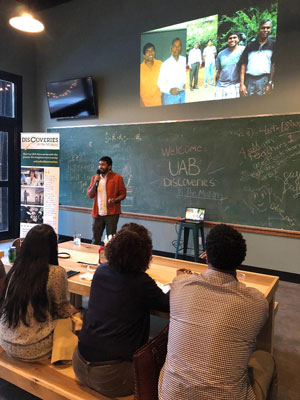The word “cancer” is a term everyone knows. Whether you’ve known somebody with cancer or have powerful images of hospitals and patient hair loss, we can all identify with the word, and the disease. There are 18.1 million new cases of cancer a year, and over half a million cancer-related deaths. The grave mortality of this disease is one far too many people are familiar with, and why the race to finding effective treatments is so important.
 Sithira Ratnayaka is running that race. A graduate student in Dr. Eugenia Kharlampieva’s lab in the department of chemistry, Ratnayaka focuses on developing targeted therapy for the treatment of cancer; one with higher efficiency and lower adverse effects. It is personal for Ratnayaka, too, as his father had a kidney tumor several years ago and had to undergo surgery and subsequent chemotherapy. When the chemo caused his father more illness than the surgery itself, Ratnayaka asked the question, “Why are the therapies used to treat cancer as harsh as the disease itself?”
Sithira Ratnayaka is running that race. A graduate student in Dr. Eugenia Kharlampieva’s lab in the department of chemistry, Ratnayaka focuses on developing targeted therapy for the treatment of cancer; one with higher efficiency and lower adverse effects. It is personal for Ratnayaka, too, as his father had a kidney tumor several years ago and had to undergo surgery and subsequent chemotherapy. When the chemo caused his father more illness than the surgery itself, Ratnayaka asked the question, “Why are the therapies used to treat cancer as harsh as the disease itself?”
Chemotherapy is the administration of cancer drugs to treat the cancer and prolong life. However, chemo is systemic meaning every cell in the body is exposed to the drug. Chemo drugs are designed to target rapidly dividing cells, and while cancer cells rapidly divide, so do other normal cells, like hair follicles. This is why many cancer patients lose their hair during chemotherapy.
Ratnayaka’s work is taking those powerful chemo drugs and packaging them in a way that will allow them to specifically target cancer cells. Specifically, he’s using microcapsules that can only be activated with ultrasound. These microcapsules are comprised of polymers and loaded with chemo drugs like doxorubicin. Once injected, the capsules circulate harmlessly throughout the body until they are excreted or activated via ultrasound technology. There are two main types of ultrasound: diagnostic and therapeutic. Both are used in conjunction to not only see the tumor and the microbeads, but also to activate them. The major advantage here is that tumors and treatment can be seen real time, as opposed to a typical MRI that can take weeks to interpret. This method can save patients precious time, and is far more comfortable for them. Further, the microcapsules are as bright as little lights on the ultrasound, allowing for the precise location of them at any given time.
 The therapeutic ultrasound is focused in on the tumor. Whenever these microcapsules circulate past the ultrasound waves, the membranes are disrupted and the drugs released. This technology allows for targeting difficult-to-reach tumors, so rather than injecting a cocktail of drugs and hoping they make it to the right area, the drugs are delivered right to the tumor itself, regardless of where it is located. Further, by controlling where the drugs are released rather than eliciting a systemic effect, adverse effects like illness and hair loss will be avoided. Cancer patients undergo enough; they should not have to suffer further with their treatments.
The therapeutic ultrasound is focused in on the tumor. Whenever these microcapsules circulate past the ultrasound waves, the membranes are disrupted and the drugs released. This technology allows for targeting difficult-to-reach tumors, so rather than injecting a cocktail of drugs and hoping they make it to the right area, the drugs are delivered right to the tumor itself, regardless of where it is located. Further, by controlling where the drugs are released rather than eliciting a systemic effect, adverse effects like illness and hair loss will be avoided. Cancer patients undergo enough; they should not have to suffer further with their treatments.
Ratnayaka is very passionate about his work and sharing it with the world.
“Scientific awareness is very important in the public eye right now,” he said. “I want to make sure that we get the support that we need for scientists nationwide.”
Cancer is a term everyone is familiar with, and while the field has advanced tremendously over the years, there is still a long road ahead for therapies. Educating people on the work that’s being done on this front has never been so important.